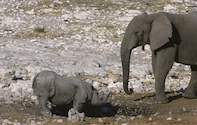
Name
Desert Elephant (Loxodonta africana)Habitat
Namibia is well known for its diversity of wildlife and the high adaptability to the harsh environment shown by the creatures that inhabit this land. This versatility is demonstrated in Namibia by all the fauna that survives here, from the smallest beetle that lives in the vast 'sand sea' of the Namib to the world's largest land mammal, the elephant.Protected Species
The Desert Elephant, which belong to the savanna elephant subspecies (Loxodonta africana cyclotis), are a protected species. However there have been incidents of poaching and in the early 1980's the number of desert elephants and rhinos declined to alarmingly low levels.Visitors to Kaokoland and Damaraland should consider themselves lucky if they see a desert elephant and blessed beyond others if they see a desert rhino. These animals are shy and their long memories have not forgotten the days when poaching was rife.Well Adapted
Desert Elephants are apparently very well adapted to living under the particular conditions of the desert. They routinely move great distances between feeding grounds and the scattered waterholes where they drink during the dry season, distances of up to 70 km being regularly traversed.Water Supply
Surface water in Kaokoland and Damaraland is very scarce and difficult to find. Elephants have long been described as the animal that never forgets and this ability is often displayed when it comes to remembering where to find the nearest water supply in a seemingly waterless area. Seasonal rivers are dependent on local rain fall before flowing above ground, however in times of drought, the water still flows, but deep under the desert sand.Eating Habits
Desert Elephants feed on a wide range of plants, and like elephants elsewhere they take leaves, shoots, bark, flowers, fruit, bulbs, tubers and roots as well as grass and sedges. They have distinct and practical seasonal feeding preferences. During the rains the elephants tend to use more grass, which then becomes abundantly available, and during the dry season they concentrate on browsing. This allows the woody plants a measure of respite for recovering during the summer.Desert Elephants eat plants like ink bush and the exotic castor oil, which are unpalatable to other animals. They also open up the dense thickets of tamarisk and acacias of the riverbeds, creating paths and shady resting places which are used by other animals. Furthermore, the remains of broken branches or felled trees lying on the ground often create sheltered nurseries for grass plants which are then protected from grazing or trampling by other animals.Location
Desert elephants are found predominantly in the Kaokoland and Damaraland regions of northwest Namibia.Field Notes
The Desert Elephants of Namibia are the same species as the African Elephant but with very different behaviour due to the extremes of their habitats. I have personally watched the Elephants feeding and they have none of the seeming wastefulness of the elephants in other parks and reserves, in fact they will move their foot away if they feel any vegetation they are about to step on.See Desert Elephants at Damaraland Lodges in Namibia

